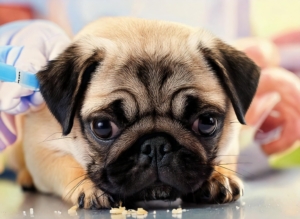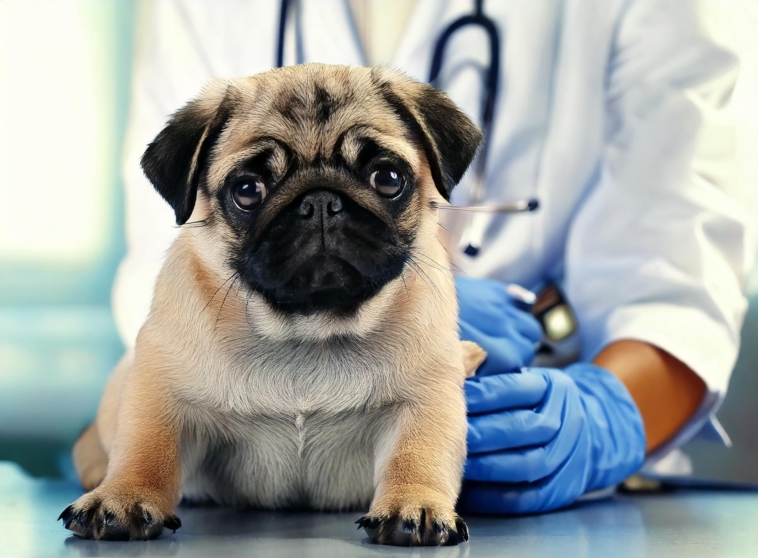Last updated on October 24th, 2024
Here’s an overview:
Introduction: Early Diagnosis of Pug Puppy Diseases
Knowing Pug-Specific Risk Factors
Breathing Issues Caused By Brachycephalic Syndrome
Eye Disease In Pug Puppy: Vets for Pets Recommends Watching For These Early Signs
Ear Infections: Symptoms, Causes, and Prevention
Pug Skin Conditions: Dryness, Allergies, and Mange
The Situations which Require an Immediate Vet Visit
Gastrointestinal Problems: Spotting Digestive Issues
Dysplasia of the Hip and Other Joint Problems In Pug
Pug Puppy Heart Disease: Signs of Possible Heads Heart Trouble
Vaccination & regular check-ups: Preventative Measures
Conclusion: Pugs Puppy diseases And Care Tips
Introduction: Early Diagnosis of Pug Puppy Diseases
Pug puppies, like any other breed, can get a few diseases once in a while. However, it is critical for the Pugs to be diagnosed early in their life for various reasons. Through genetics, pugs are susceptible to a myriad of health concerns. It is possible to reduce:
- Medical attention Sentiment
- Treatment Expenses
- Damaging End Results
Tardiness in the diagnosis can lead to the development of more complex problems and treatments that are likely to be ineffective. Routine health examinations are always encouraged by veterinarians in order to help screen for potential issues. These routines include checking the Pug for lethargy, coughing, skin lesions, and other signs of illness to avert minor problems from aggravating. It is the owner’s concern, awareness, and caution that strives to make all Pugs healthy once they grow up.
Knowing Pug-Specific Risk Factors
Like all other dogs, Pugs are naturally built in a certain way, which predisposes them to certain conditions. These are almost always due to their compact build and short-nosed, or brachycephalic type of structure.
Most prevalent diseases
- Brachycephalic oxygen obstructive airway syndrome (BOA’s) as this leads breath to be difficult. as the person lacking exercise tolerance.
- Hip Dysplasia as this invasion tends to be a debilitating condition in health of joints in joints.
- Skin Fold Dermatitis because it occurs mostly to these folds but especially on the facial folds when these folds occur.
- Ocular Problems This includes cherry eyes, cataracts
Knowing these conditions enables us to act quickly and prevent these diseases, which ensures wellbeing of pug puppies.
Breathing Issues Caused By Brachycephalic Syndrome
Pugs and other dogs with broad heads have Brachycephalic syndrome, a disorder related to the respiratory system, which affects their breathing. Typical symptoms include:
- Abnormal Noise While Breathing: Patients make a loud snorting sound when they breathe.
- Lack of Endurance To Perform Activities: Patients cannot do any physical exercise without getting tired very quickly.
- Episodic Gagging or Vomiting Episodes: Episodes occurring after meals or periods of exertion.
- Bluish Discoloration: This happens when the lungs fail to deliver satisfactory oxygen to the tissues.
- Significant Snoring: Pugs tend to snore very loudly when they are asleep.
- Frequently Protracted Neck: Ordinarily, there is neck stretching for easier function…
Proper treatment begins with immediate intervention from veterinarians. Life can be pleasant if certain things are taken care of beforehand.
Eye Disease In Pug Puppy: Vets for Pets Recommends Watching For These Early Signs
Due to their distinct structure, pug puppies are likely to develop a number of eye disorders.
Some Eyelid Problems Include:
- Corneal Ulcers: Check the patient for photophobia and excessive tears or pus.
- Keratoconjunctivitis Sicca: Exhibits redness, abnormal discharge, and constant tightening of the eye.
- Entropion: Patients generally suffer from rolling and excessive eye tears and pawing.
- Cherry Eye: Look for reddish, falling lumps located in the corner of the eye.
Helpful Suggestions:
- If any discomfort or abnormality is experienced in the eyes, it should be reported immediately.
- Take pets for regular check-ups to the local veterinarian.
- Expose the animal to the necessary care to avoid contracting any infections.
Ear Infections: Symptoms, Causes, and Prevention
Symptoms:
- Ear scratching
- Shaking the head
- Brownish-yellowish bloody discharge
- Unpleasant smell
- Swelling or redness
- Swellings or scabs
Causes:
- Bacteria
- Fungus
- Allergens
- Accumulation of moisture
- Scabies
- Foreign materials
Prevention:
- Clean their ears on a regular basis
- After a soak in water, dry the ear properly
- Assess the risk of foreign objects being present
- Treat allergens
- Feed appropriate amounts which balance their diet
- Steer clear away from dirty surroundings
Cleanliness of the ears can protect from ear infections in pets. It is very important to have regular vet visits to address any problems that will come up in the future.
Pug Skin Conditions: Dryness, Allergies, and Mange
Skin conditions are common in pug puppies which include dryness, allergy, and, mange. Correct1 timing is crucial to effective intervention.
- Dryness: Can occur when the skin is lacking moisture causing it to be itchy. Ensure fluids are consumed or use a lotion alternative advocated by a veterinarian.
- Allergies: An inflamed itchy skin with plenty of redness and soreness is often experienced. Check all possible causes that may be the allergen like food items or an element in the environment.
- Mange: Caused by mite infestation with loss of hair and some sores. Subtypes include demodectic and sarcoptic mange. The veterinary practitioner is the best person to diagnose the type of mange present, seek the services of one for accurate treatment.
Severe skin conditions pug puppies can develop can be avoided or minimized through proper and careful grooming and watching closely.
The Situations which Require an Immediate Vet Visit
Seeking veterinary advice is necessary when owners observe the following signs:
- Difficulty in Breathing: In cases of difficulty in breathing, look for sucking in of the ribs, fast breathing with gasps, or blue-colored gums.
- Seeming to be trying to Constantly Vomit or Pass Out Liquid Waste: Several consecutive attempts within a few hours may predispose the individual to dehydrate.
- Seizures of any kind: They include faint twitching episodes. Each event requires seeking urgent attention.
- Lethargy or extremities that are devoid of energy: Weakness or overall unresponsiveness is indeed worrying.
- Abdominal Distention: Abdominal discomfort or evident distention with tenderness upon palpation maybe a harbinger of an urgent medical condition.
- Losing blood: Bandage massive and uncontrollable blood loss from any part of the body immediately.

Gastrointestinal Problems: Spotting Digestive Issues
Puppies suffering from gastrointestinal upsets may not be easy to diagnose. All that is needed is to be in the looks for the following signs:
- Vomit: Vomiting that is frequent points towards a stomach upset or putrefactive conditions from infection.
- Diarrhea: Diarrhea having loose watery stool caused by the digestive system not functioning well or bacterial conditions.
- Constipation: Absence of stool with apparent effort when passing stool indicates something wrong with diet and or health.
- Loss of Appetite: Lack of interest in food or deliberate efforts to avoid food could be indications of pain or illness.
- Abdominal Pain: Pugs whimper or do not act lively, and kicking their tummies is quite normal.
Any combination of symptoms as described above is worth noticing. Timely detection and care becomes the key to ensure the puppy receives the appropriate treatment and feels comfortable.
Dysplasia of the Hip and Other Joint Problems In Pug
Due to their conformation, Pugs tend to suffer from particular types of orthopaedic conditions more.
Common Signs and Symptoms:
- Pawing at one leg or dragging it around
- Pain while getting up from sitting, sleeping or lying down position
- Reduction or disinterest in playing around
Hip Dysplasia:
Due to the hip not developing adequately, hip dysplasia can lead to a lot of pain and trouble moving. It is important to pay attention to any differences when walking as well.
Patellar Luxation:
Precipitates patellar luxation which is the dislocation of the kneecap. As such this is typically noticed in the skipping gait.
Early Detection:
- Take pets to the vet regularly
- Look at how the pet moves or any unusual behaviour
- If there is any limp or swelling then report immediately
If any of these conditions are addressed early on, life will be considerably nicer for your pug.
Pug Puppy Heart Disease: Signs of Possible Heads Heart Trouble
The heart and life organs of pug puppies are quite important, and any issue regarding proper functioning should be addressed.
Signs of Heart disease in Pug puppies:
- Chronic coughing: Coughs, especially after activities, or during stillness periods.
- Hyperventilation: Breaths fast quite a lot, even when still.
- Loss of Consciousness/hypoxemia: A length of unavailability of oxygen triggers fainting.
- Weakness: Severe tiredness which leads to unwillingness to engage in play.
- Enlarged abdomen (especially in the belly region): Emergence of fluid in the regions around the belly or the abdomen.
- Dull gums and tongues in color: Coloring may change to pale or blue which denotes lack of adequate oxygen.
Look out for the signs so start looking for a vet at once. So looking out for these symptoms early enough can help prevent dealing with a much more serious health condition in the future.
Vaccination & regular check-ups: Preventative Measures
Taking your Pug puppy to the vet for regular health checks and vaccination is very important to their health even when they are still very young.
Vaccination Schedule:
- Get your vaccinations on schedule from a veterinarian.
- Core vaccines include Distemper, Parvovirus, and Canine Adenovirus
- Optional vaccines include Bordetella, Canine Influenza
Regular Check-Ups:
- Make sure you take your pet for check-ups at least biannually.
- Check for reduction in weight, dental cavities, and overall health.
- Heart, lungs and skin problems should be seen early on.
Constant monitoring is a good means of ensuring disease will not occur or if it does, it can be treated early on. These two interventions in the form of vaccinations and regular visits to the vet will go a long way in ensuring the pug puppies lead healthy lives.
Conclusion: Pugs Puppy diseases And Care Tips
Proper care for a Pug puppy encompasses regular visits to the veterinarian, proper nutrition, and moderate activities. Any pet owner should be on the lookout for any likely threats to health and maintain proper hygiene within reach. Other useful steps include:
- Keeping the timetable of administered vaccines regular
- Offering the right forms of interaction with other pets and human beings
- Observing the presence of many other disease such as obesity and respiratory diseases
Article by: Tawab Sukhera (Ethologist)




